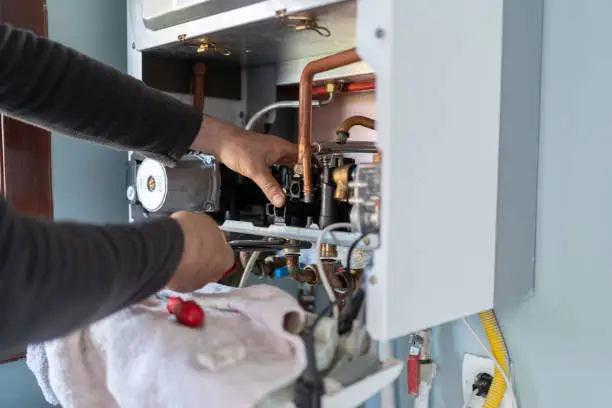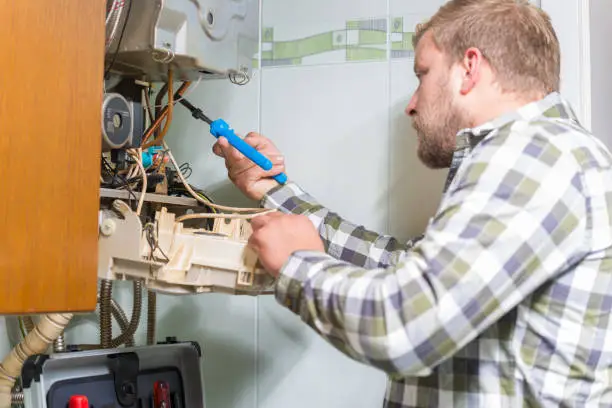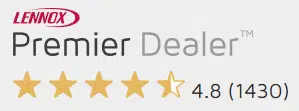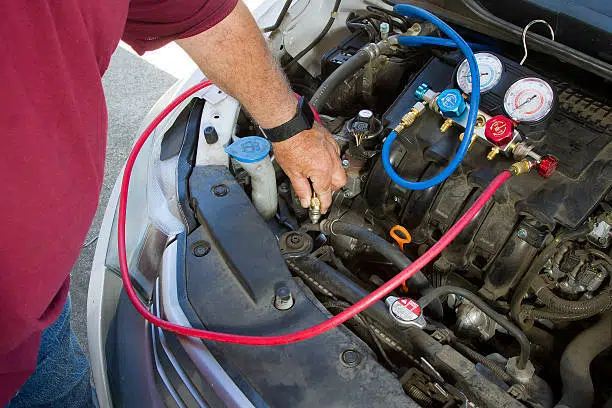
Table of Contents
- Why Does Furnace Filter Direction Matter?
- How to Know Which Way Your Furnace Filter Goes
- What Happens If You Install the Filter Backward?
- Common Filter Installation Mistakes
- When Should You Check Your Filter?
- Furnace Filter Maintenance Tips
- Why You Should Consider Professional Maintenance
- Final Thoughts
- FAQ
Changing your furnace filter might not seem like a big deal, but it’s one of those tasks that can affect your HVAC system more than you’d expect. One detail that often trips people up is the furnace filter direction. If you’ve ever wondered whether that arrow on the side of your filter matters—spoiler alert—it definitely does. The direction you install your furnace filter can make a big difference in your system’s efficiency, furnace air flow, air quality, and longevity.
Why Does Furnace Filter Direction Matter?
The furnace filter has a simple but important job: to trap dust, dirt, and other airborne particles before they get pulled into your HVAC system. It’s a key factor in keeping your system clean and maintaining good indoor air quality. But here’s the catch: the filter must be installed in the right furnace filter direction to work properly. When you install it the wrong way, it disrupts the furnace air flow, causing issues for the entire system.
If the filter is placed backward, air won’t flow through it efficiently. This forces your furnace to work harder, putting unnecessary strain on the system. Over time, this leads to reduced efficiency, higher energy bills, and potentially even system breakdowns. So, yes, the furnace filter direction matters—more than you might think.
How to Know Which Way Your Furnace Filter Goes
Luckily, figuring out the correct furnace filter direction is pretty simple. Most filters have an airflow arrow printed on the frame. That arrow indicates which way the furnace air flow should go. Air is always sucked into your system through return ducts and passes through the filter before reaching the furnace. So, the arrow should always point toward the furnace or blower motor.
Think of it like this: air is drawn from your home, passes through the filter to get cleaned, and then enters the furnace to be heated or cooled. By aligning the filter with the furnace air flow, you ensure the system pulls in clean air without resistance.
If your filter doesn’t have an arrow, look for the reinforced side (often made with wire mesh). This side should face the furnace, as it’s built to handle the force of the air being pulled through. The softer, pleated side of the filter is where the dust and debris get trapped.
What Happens If You Install the Filter Backward?

If you accidentally install your furnace filter backward, you’ll notice a drop in system efficiency. The dense, pleated side will be blocking the airflow, making it harder for air to pass through. This restricts furnace air flow and forces the system to work harder to heat or cool your home. Over time, this not only drives up your energy bills but also puts extra strain on your HVAC system, potentially leading to costly repairs or early system failure.
Additionally, when the filter isn’t facing the correct furnace filter direction, it won’t capture dust and dirt as effectively. That means debris can make its way into your furnace, clogging the blower motor or dirtying the heat exchanger—issues that can result in expensive repairs.
If you’re unsure about changing the filter yourself, feel free to reach out to our professional furnace repair service in Canada for assistance.
Common Filter Installation Mistakes
A lot of homeowners assume that changing a furnace filter is foolproof, but there are a few common mistakes that can cause problems down the road. Here’s a quick list to help you avoid the most frequent slip-ups:
- Ignoring the airflow direction: As we’ve covered, the filter must align with the airflow. If you install it backward, the system can’t breathe properly.
- Thinking a snug fit is enough: Just because the filter fits snugly in place doesn’t mean it’s installed correctly. Always check for the airflow arrow.
- Forgetting to change the filter regularly: Even the right filter installed correctly will cause issues if it’s clogged with dust. Make sure you’re changing it every 1-3 months, depending on how often you use your furnace.
- Using the wrong filter size: An improperly sized filter won’t work effectively. A filter that’s too small might let air (and dust) bypass it completely, while a filter that’s too big can get bent or damaged during installation. Always double-check the size before you buy.
Check out our previous guide on how to install the furnace filter properly via the link below.
https://thehvacservice.ca/how-to-install-a-furnace-filter-properly/
When Should You Check Your Filter?
Checking your furnace filter doesn’t need to be a constant chore, but you should take a look at it each time you replace it. It’s easy to forget whether you installed it correctly last time, so why not take a quick moment to verify the furnace filter direction?
Most filters need to be replaced every 1-3 months, but it can depend on factors like your home’s air quality, the season, and whether or not you have pets. During the colder months when your furnace is running more frequently, you may need to change it more often. In any case, checking for the airflow arrow is a small task that can prevent bigger problems later on.
Furnace Filter Maintenance Tips

To keep your HVAC system running smoothly and efficiently, a little regular maintenance goes a long way. Here are a few tips to help you stay on top of your furnace filter game:
- Set a filter replacement schedule: Mark your calendar or set a reminder to check your filter every 1-3 months. This ensures you won’t forget to change it.
- Buy extra filters in advance: Having a couple of spares on hand makes it easy to swap out your filter when it’s time for a change.
- Use smart thermostat reminders: Many modern thermostats allow you to set up reminders for filter changes. Let technology help you out!
- Keep an ear out for unusual noises: If you start hearing strange noises coming from your furnace, it could be a sign of poor airflow caused by a clogged or incorrectly installed filter.
- Monitor energy bills: A sudden spike in your energy bills could indicate that your system is working harder than it should—often a result of a dirty or misaligned filter.
While these tips will help keep your system in good shape, don’t forget that regular professional maintenance is essential. A certified HVAC technician can inspect your entire system, clean important components, and make sure everything is running as efficiently as possible. This kind of preventative care can save you from dealing with costly repairs or unexpected breakdowns, especially when you need your system the most during those freezing Canadian winters.
Why You Should Consider Professional Maintenance
Sure, changing your furnace filter is something you can do yourself, but that doesn’t mean you should skip professional furnace maintenance altogether. Your HVAC system is a complex piece of equipment, and small issues can escalate quickly if left unchecked. Bringing in a pro to inspect your system ensures that everything’s working as it should.
At HVAC Service Solutions, we’re here to help with all your HVAC needs, from routine filter changes to full system inspections. Our trained technicians know how to spot potential problems before they turn into expensive repairs, helping you keep your system running efficiently all year long. Whether it’s filter replacements, furnace tune-ups, or emergency repairs, we’ve got you covered.
Final Thoughts
Getting the furnace filter direction right might seem like a small thing, but it can have a big impact on your HVAC system’s performance. By making sure your filter is installed correctly, you’re helping to improve furnace air flow, protect your system from unnecessary wear, and keep your home’s air clean.
If you have any doubts or need assistance, our team at HVAC Service Solutions is here to make sure your HVAC system is in top shape. Don’t hesitate to reach out for help with your furnace or any other heating and cooling needs!
Frequent Asked Questions
How often should I change my furnace filter?
You should change your furnace filter every 1-3 months, depending on factors like the type of filter, how often you use your HVAC system, and the air quality in your home. If you have pets, allergies, or live in a dusty area, you might need to replace it more frequently. Some higher-efficiency filters can last up to 6 months, but it’s always a good idea to check the filter periodically. If it looks dirty or clogged, it’s time for a change. Keeping a clean filter ensures proper airflow and improves your system’s efficiency. Not changing it on time can increase your energy bills and strain the furnace.
Which way should the furnace filter face?
The furnace filter should be installed in the direction of airflow, which is typically toward the furnace or blower motor. Most filters have an arrow on the side indicating the airflow direction. This arrow should always point toward the furnace. If the filter is installed backward, it can block airflow, making your system work harder and reducing its efficiency. A backward filter also won’t trap dirt and dust effectively, potentially allowing debris to damage your furnace. If you’re unsure, feel free to contact HVAC Service Solutions, and we’ll help ensure your filter is installed properly.
What happens if I install my furnace filter backward?
Installing a furnace filter backward can restrict airflow, causing your system to work harder than necessary. This not only decreases efficiency but can also lead to higher energy bills and potential damage to your HVAC system. A backward filter won’t trap dust and debris properly, meaning dirt can accumulate in your furnace, clogging key components like the blower motor. Over time, this can result in costly repairs. Always make sure the airflow arrow on the filter points toward the furnace for optimal performance.
Can I use any filter size for my furnace?
No, it’s essential to use the correct filter size for your furnace. Each system is designed to work with a specific filter size, which ensures optimal airflow and filtration. Using a filter that’s too small can allow unfiltered air to bypass the filter, while a filter that’s too large may not fit properly and could be damaged during installation. The correct size is usually printed on the side of the filter or in your furnace manual. If you’re unsure about which filter to use, give HVAC Service Solutions a call, and we’ll help you find the right one.
Why is my furnace making strange noises after I changed the filter?
If your furnace is making unusual noises after a filter change, it could be due to poor airflow caused by an incorrect filter installation or a clogged filter. Double-check that the filter is installed in the correct direction and that it’s the right size for your system. If the filter is too dirty or restrictive, the system may struggle to draw air, causing rattling or whistling noises. If the noises persist, it might be time for a professional inspection to check for other underlying issues. It’s always a good idea to contact a technician at HVAC Service Solutions to assess the problem.
What is MERV, and how does it affect my furnace filter?
MERV stands for Minimum Efficiency Reporting Value, which rates the effectiveness of air filters on a scale from 1 to 16. A higher MERV rating means better filtration, capturing smaller particles like dust, pollen, and even bacteria. However, a filter with too high of a MERV rating can restrict airflow, especially in residential HVAC systems not designed for it. It’s important to choose a filter with the right MERV rating for your furnace—usually between 8 and 13 for most homes.
Can a dirty furnace filter affect my energy bills?
Yes, a dirty furnace filter can significantly increase your energy bills. When the filter is clogged with dust and debris, it restricts airflow, making your furnace work harder to push air through. This increased effort requires more energy, leading to higher utility costs. A clean filter allows your furnace to operate efficiently, maintaining consistent airflow and reducing energy consumption. Replacing your filter regularly is one of the simplest and most effective ways to lower your energy bills and prolong the life of your HVAC system.
How do I know if my furnace filter is dirty?
You can tell if your furnace filter is dirty by checking its appearance. If the filter looks gray, covered in dust, or has visible debris buildup, it’s time to replace it. Some filters have indicator strips that change color when the filter needs changing. You may also notice other signs of a dirty filter, such as reduced airflow from your vents, uneven heating in your home, or an increase in energy bills. If you’re experiencing these issues, check your filter immediately. Regularly changing your filter is key to maintaining system efficiency.
Can I run my furnace without a filter temporarily?
While it’s technically possible to run your furnace without a filter for a short period, it’s not recommended. The filter’s job is to trap dust, dirt, and debris, preventing them from entering your furnace and causing damage. Without a filter, these particles can accumulate inside your system, leading to reduced efficiency, costly repairs, and poor indoor air quality. If you need to replace your filter but don’t have one on hand, it’s better to wait until you do. Running the system without a filter, even temporarily, can cause long-term harm.
Is it okay to use reusable or washable furnace filters?
Reusable or washable furnace filters can be a good option for some homeowners, but they require regular maintenance. These filters need to be washed and dried thoroughly before reinstalling them. However, reusable filters typically have a lower MERV rating, meaning they don’t capture as many fine particles as disposable filters. Additionally, they can wear out over time, becoming less effective at trapping dust and debris. If you’re unsure whether a reusable filter is right for your system, contact HVAC Service Solutions, and we’ll help you find the best option for your home.
Share



















